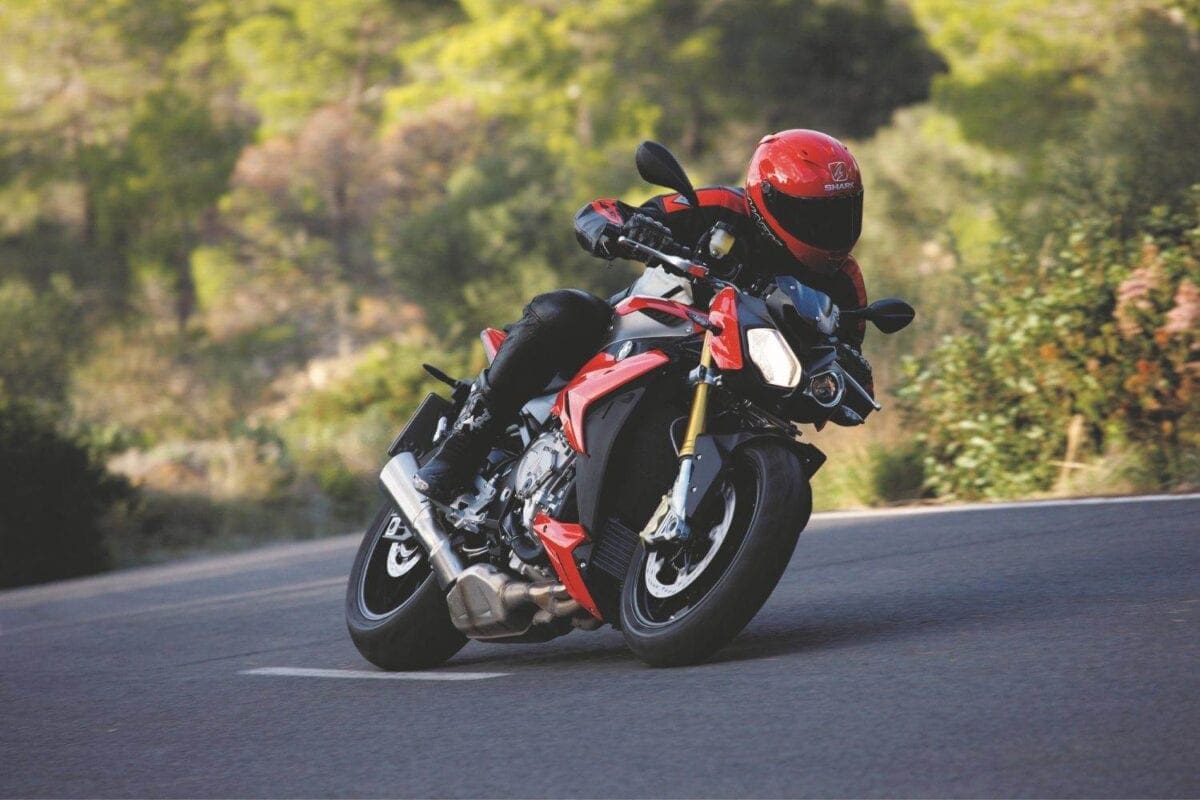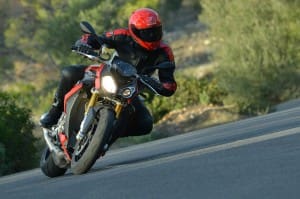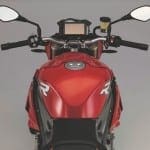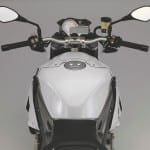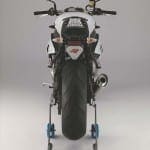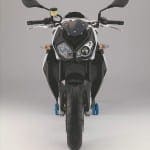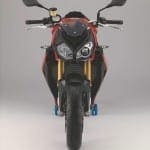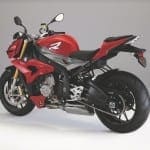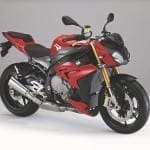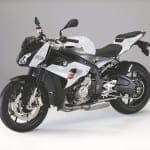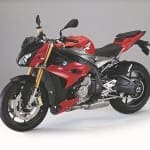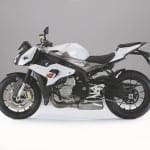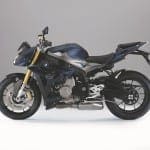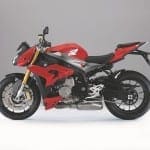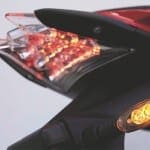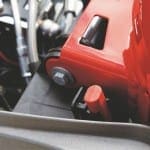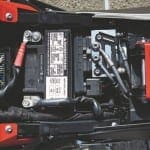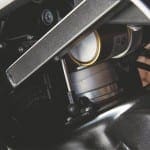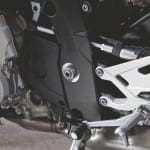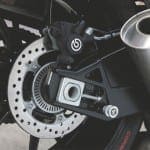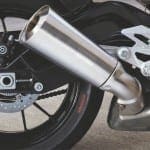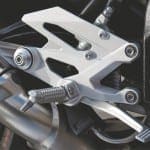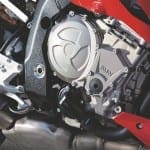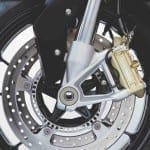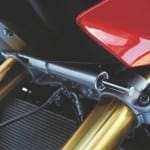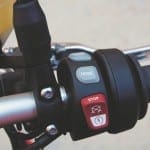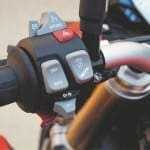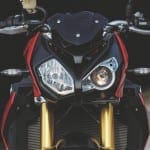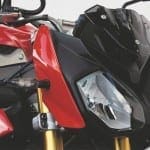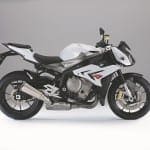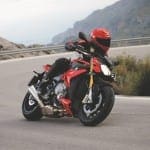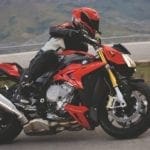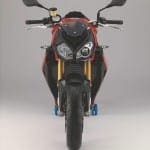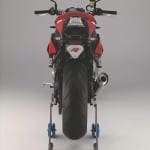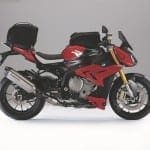£11,390 | Liquid-cooled four cylinder | 160bhp | 83lb-ft
Tested by Roland Brown. Motorcycle Journalist and former international racer, Roland Brown is one of the world’s most respected bike testers. Subscribe to his fantastic YouTube channel – iMotorcycle Video – here.
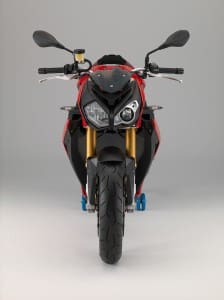 It’s four years since BMW dropped the 190bhp bombshell of the S1000RR on the motorcycle world, going straight to the top of the super-sports class and beginning a new era of road-test superlatives and World Superbike race wins. A stripped-down naked four seemed sure to follow, yet despite many rumours and spy photos we’ve had to wait until now for the S1000R.
It’s four years since BMW dropped the 190bhp bombshell of the S1000RR on the motorcycle world, going straight to the top of the super-sports class and beginning a new era of road-test superlatives and World Superbike race wins. A stripped-down naked four seemed sure to follow, yet despite many rumours and spy photos we’ve had to wait until now for the S1000R.
BMW have plenty of reasons for taking some time to create it. They’ve been busy developing other models (four more at this year’s Milan show), and they already had the beefy naked K1300R in the range. Equally importantly, building a lightweight naked sportster around a motor of such power involved far more than simply ripping off its fairing and bolting a flat, one-piece bar to the top yoke.
But finally the S1000R is officially here — or at least it’s launched and will be in showrooms next March. With its wide, raised one-piece bar it’s undoubtedly a super-naked but strictly speaking it’s not naked at all, having not just a headlamp fairing and tiny flyscreen but also fairing side pieces with familiar RR-style gills.
There are two versions of the S1000R. The standard bike has two riding modes and comes with BMW’s basic ASC traction control. The S1000R Sport adds two more riding modes, a quick-shifter, the more sophisticated Dynamic Traction Control, LED indicators, a colour-matched belly-pan and Dynamic Damping Control semi-active suspension.
Tell me about the engine
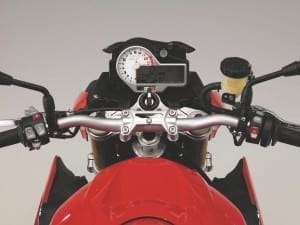 It’s heavily based on the S1000RR’s dohc, 16-valve engine but is detuned with a reworked cylinder head, softer cams, revised injection system and new four-into-one exhaust. The rev limit is reduced by 2000rpm to 12,000rpm, and the peak power output is 160bhp, well down on the RR’s 190bhp. But the peak torque figure of 112Nm is unchanged, and the R-bike makes more torque everywhere below 9000rpm.
It’s heavily based on the S1000RR’s dohc, 16-valve engine but is detuned with a reworked cylinder head, softer cams, revised injection system and new four-into-one exhaust. The rev limit is reduced by 2000rpm to 12,000rpm, and the peak power output is 160bhp, well down on the RR’s 190bhp. But the peak torque figure of 112Nm is unchanged, and the R-bike makes more torque everywhere below 9000rpm.
So it’s a very powerful engine by naked bike standards and it’s also very sophisticated, with ride-by-wire throttle control, multiple modes and traction control. The standard model gets two engine modes, Road and Rain (selectable via a button on the right bar), with the latter giving softer delivery to a lower 136bhp max, and differing level of ASC (Automatic Stability Control). The Sport’s extra modes, Dynamic and Dynamic Pro, are for sporty riding. They’re also linked to the Dynamic Traction Control, which as with the S1000RR is governed by a lean angle sensor.
What’s the chassis like?
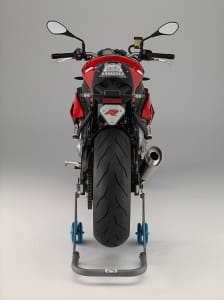 In similar fashion the twin-spar aluminium frame is based on the RR’s, but modified for naked bike use with more relaxed steering geometry and a longer wheelbase to give extra stability with the more upright riding position and those wide bars out in the breeze.
In similar fashion the twin-spar aluminium frame is based on the RR’s, but modified for naked bike use with more relaxed steering geometry and a longer wheelbase to give extra stability with the more upright riding position and those wide bars out in the breeze.
The standard S1000R gets 46mm upside-down forks and works the twin-sided aluminium swing-arm via a conventional monoshock. The Sport model’s DDC semi-active suspension is closely based on the super-sports HP4’s. It changes with riding mode, and automatically adapts its damping levels to suit the current riding situation. BMW haven’t skimped on the spec because the S1000R also gets Brembo radial four-piston calipers with ABS as standard. The ABS settings also vary with riding mode, with Dynamic Pro disabling rear wheel anti-lock to allow skids. Wheels are wide 17-inchers wearing Pirelli’s sticky Diablo Rosso Corsas.
Should I buy one?
If you’re looking for a powerful naked bike the BMW has surely got to be on your short-list, not least because both models are so competitively priced. The standard model sneaks in below the ten-grand mark at £9990. Although we haven’t ridden it yet (the launch bikes were all Sports) that looks seriously good value for a bike of this performance and quality. Kawasaki’s freshly updated Z1000 is arguably the best of the Japanese opposition. That costs £9699 in its basic form but £10,099 with ABS, and is less powerful, heavier and can’t match the BMW for sophistication.
The S1000R Sport is arguably even better value at £11,390. With its choice of four engine modes, semi-active suspension and quick-shifter it’s a seriously sophisticated bike for sensible money. Its closest rival is probably Aprilia’s excellent Tuono V4R ABS, which makes 170bhp, comes with APRC traction control and costs £12,432. KTM’s eagerly awaited 1290 Super Duke R is another formidable rival but its £13,999 price looks distinctly steep alongside the Sport’s.
In a word: exciting. With stunning acceleration, sweet handling, powerful braking, light weight and generous levels of grip and ground clearance, the S1000R is very nearly as quick as any super-sports bike, and arguably more fun. And the Sport, especially, is also respectably practical and even comfortable, at least by naked bike standards.
The riding position is typically upright, with an easy reach to the bars and a fair bit of legroom despite fairly high and rearset footrests. The engine is superb: powerful, smooth and free-revving. The S1000R can’t approach the RR’s ballistic high-rev performance but for roadgoing use it more than compensates with its additional flexibility and stunning midrange response. Despite the tiny fly-screen there’s not much wind protection so neck muscles get a work-out at higher speeds — but hey, it’s a naked bike, right?
Throttle response is excellent in all the riding modes, making for instant acceleration whether you’re rolling it on from 6000rpm or revving to the redline with the help of the efficient quick-shifter. When ridden hard the BMW is a seriously rapid bike, aided by its wet weight figure of just 207kg which is near identical to the RR’s. And it’s also impressively controllable, helped by the excellent DTC traction control system, which is there in the background in case you need it but doesn’t get in the way (even if you want to pull wheelies).
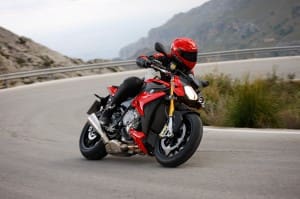 Chassis performance is equally impressive. On Road setting the BMW gives an improbably plush ride, gliding over most urban bumps as though they’re hardly there. It’s fine even for hard riding but you’re better off pressing the button to select Dynamic mode, which firms up the suspension and gives a superbly taut and controlled ride. Both ends can also be fine-tuned through soft, normal and hard settings via a button on the left bar.
Chassis performance is equally impressive. On Road setting the BMW gives an improbably plush ride, gliding over most urban bumps as though they’re hardly there. It’s fine even for hard riding but you’re better off pressing the button to select Dynamic mode, which firms up the suspension and gives a superbly taut and controlled ride. Both ends can also be fine-tuned through soft, normal and hard settings via a button on the left bar.
Other chassis parts work well, with the Brembo radial front calipers giving predictably fierce stopping power. They’re normally very well backed-up by the ABS system, although I actually crashed the bike after losing the front end under braking on a very slippery damp patch exiting a tunnel (while in Dynamic Pro mode, which is intended for dry surfaces). I’m still not sure why it happened but the incident wouldn’t put me off buying the BMW.
Like other naked bikes the S1000R isn’t especially practical, but it’s better than some. Fuel consumption should be over 40mpg, so you should get close to 150 miles from the 17.5-litre tank. The plush suspension made the seat seem reasonably comfortable, though there’s not much room for a pillion. The digital instrument panel is comprehensive, and the Sport even comes with heated grips as standard.
Tech Spec
Price: £11390 (£9990 for S1000R)
Engine: Liquid-cooled inline four cylinder
Power: 160bhp (119kW) @ 11,000rpm
Torque 83lb-ft (112Nm) @ 9250rpm
Kerb weight: 207kg
Seat height: 814mm
Tank size: 17.5 litres

